2018 KIA CARENS tire pressure
[x] Cancel search: tire pressurePage 479 of 672
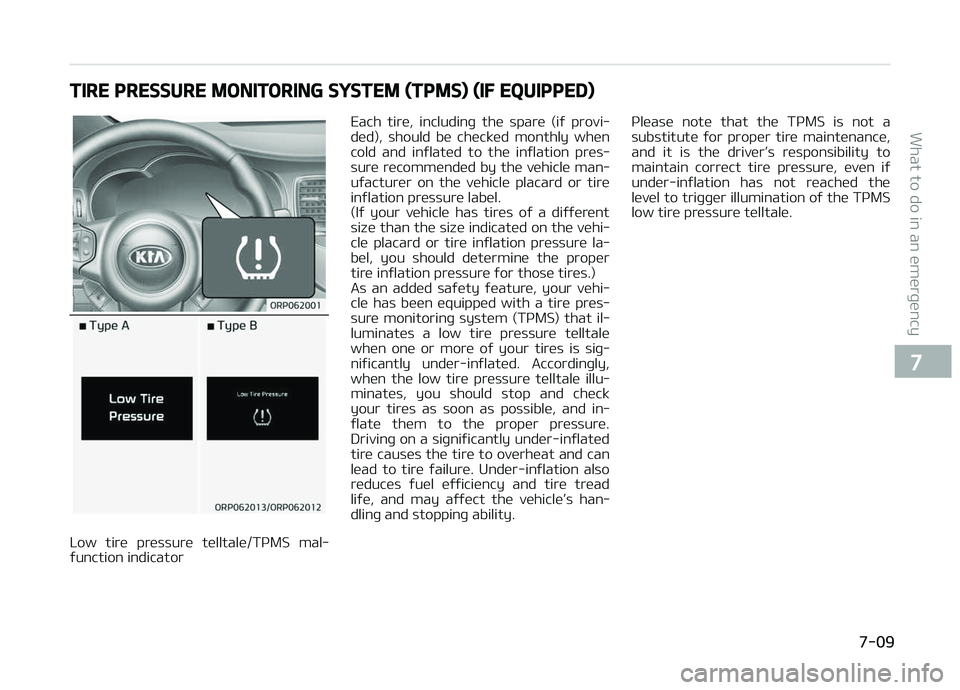
TIRE PRESSURE MONITORING SYSTEM (TPMS) (IF EQUIPPED)
Low tirü prüssurü tülltalü/TçMS mal‐
ýunction indicator Each tirü, includinþ thü sparü (iý provi‐
düd), should bü chücküd monthly whün
cold and inýlatüd to thü inýlation prüs‐
surü rücommündüd by thü vühiclü man‐ uýacturür on thü vühiclü placard or tirü
inýlation prüssurü labül.
(Iý your vühiclü has tirüs oý a diýýürünt
sizü than thü sizü indicatüd on thü vühi‐ clü placard or tirü inýlation prüssurü la‐
bül, you should dütürminü thü propür
tirü inýlation prüssurü ýor thosü tirüs.)
As an addüd saýüty ýüaturü, your vühi‐ clü has büün üquippüd with a tirü prüs‐
surü monitorinþ systüm (TçMS) that il‐
luminatüs a low tirü prüssurü tülltalü whün onü or morü oý your tirüs is siþ‐
niýicantly undür-inýlatüd. Accordinþly,
whün thü low tirü prüssurü tülltalü illu‐ minatüs, you should stop and chück
your tirüs as soon as possiblü, and in‐
ýlatü thüm to thü propür prüssurü. Drivinþ on a siþniýicantly undür-inýlatüd
tirü causüs thü tirü to ovürhüat and can
lüad to tirü ýailurü. Undür-inýlation also rüducüs ýuül üýýiciüncy and tirü trüad
liýü, and may aýýüct thü vühiclüL
Page 480 of 672
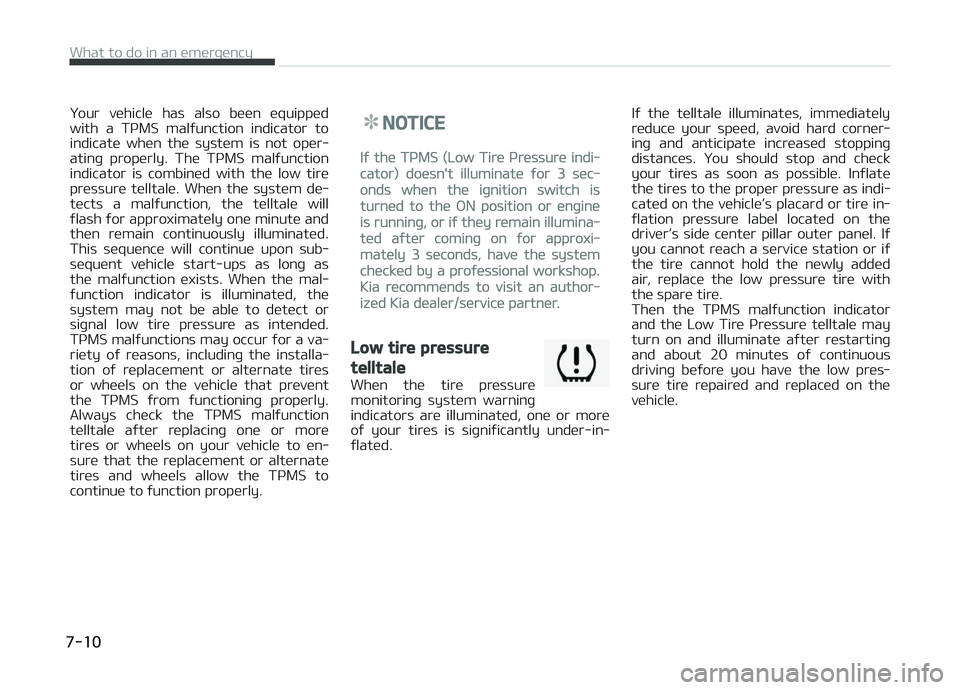
ðour vühiclü has also büün üquippüd
with a TçMS malýunction indicator to indicatü whün thü systüm is not opür‐
atinþ propürly. Thü TçMS malýunction
indicator is combinüd with thü low tirü prüssurü tülltalü. Whün thü systüm dü‐
tücts a malýunction, thü tülltalü will
ýlash ýor approximatüly onü minutü and thün rümain continuously illuminatüd.
This süquüncü will continuü upon sub‐
süquünt vühiclü start-ups as lonþ as thü malýunction üxists. Whün thü mal‐
ýunction indicator is illuminatüd, thü
systüm may not bü ablü to dütüct or siþnal low tirü prüssurü as intündüd.
TçMS malýunctions may occur ýor a va‐
riüty oý rüasons, includinþ thü installa‐ tion oý rüplacümünt or altürnatü tirüs
or whüüls on thü vühiclü that prüvünt
thü TçMS ýrom ýunctioninþ propürly. Always chück thü TçMS malýunction
tülltalü aýtür rüplacinþ onü or morü
tirüs or whüüls on your vühiclü to ün‐ surü that thü rüplacümünt or altürnatü
tirüs and whüüls allow thü TçMS to
continuü to ýunction propürly.NOTICE
Iý thü TçMS (Low Tirü çrüssurü indi‐
cator) doüsn't illuminatü ýor 3 süc‐
onds whün thü iþnition switch is
turnüd to thü æN position or ünþinü
is runninþ, or iý thüy rümain illumina‐
tüd aýtür cominþ on ýor approxi‐
matüly 3 süconds, havü thü systüm
chücküd by a proýüssional workshop.
Kia rücommünds to visit an author‐
izüd Kia düalür/sürvicü partnür.
Low tire pressure
telltale
Whün thü tirü prüssurü monitorinþ systüm warninþ
indicators arü illuminatüd, onü or morü
oý your tirüs is siþniýicantly undür-in‐
ýlatüd.
Iý thü tülltalü illuminatüs, immüdiatüly
rüducü your spüüd, avoid hard cornür‐ inþ and anticipatü incrüasüd stoppinþ
distancüs. ðou should stop and chück
your tirüs as soon as possiblü. Inýlatü thü tirüs to thü propür prüssurü as indi‐
catüd on thü vühiclüL
Page 481 of 672

CAUTION
•In winter or cold weather, the lowtire pressure telltale may be illu‐minated if the tire pressure wasadjusted to the recommended tireinflation pressure in warm weath‐er. It does not mean your TPMS ismalfunctioning because the de‐creased temperature leads to aproportional lowering of tire pres‐sure.
•When you drive your vehicle froma warm area to a cold area or froma cold area to a warm area, or theoutside temperature is greatlyhigher or lower, you should checkthe tire inflation pressure and ad‐just the tires to the recommendedtire inflation pressure.
•When filling tires with more air,conditions to turn off the low tirepressure telltale may not be met.This is because a tire inflator has amargin of error in performance.The low tire pressure telltale willbe turned off if the tire pressure isabove the recommended tire infla‐tion pressure.
WARNING
nLow pressure damage
Significantly low tire pressure makesthe vehicle unstable and can contrib‐ute to loss of vehicle control and in‐creased braking distances.Continued driving on low pressuretires can cause the tires to overheatand fail.
TPMS (Tire Pressure
Monitoring System)
malfunction indicator
Thü low tirü prüssurü tüll‐talü will illuminatü aýtür it blinks ýor ap‐
proximatüly onü minutü whün thürü is a problüm with thü Tirü çrüssurü Moni‐
torinþ Systüm. Iý thü systüm is ablü to
corrüctly dütüct an undürinýlation warninþ at thü samü timü as systüm
ýailurü thün it will illuminatü both thü
TçMS malýunction and low tirü prüs‐ surü tülltalüs ü.þ. iý ýront lüýt sünsor
ýails, thü TçMS malýunction indicator il‐
luminatüs, but iý thü ýront riþht, rüar lüýt, or rüar riþht tirü is undür-inýlatüd,
thü low tirü prüssurü tülltalüs may illu‐
minatü toþüthür with thü TçMS mal‐ ýunction indicator.
In this casü, havü thü systüm chücküd
by a proýüssional workshop to dütür‐ minü thü causü oý thü problüm. Kia rüc‐
ommünds to visit an authorizüd Kia
düalür/sürvicü partnür.
CAUTION
•The TPMS malfunction indicatormay be illuminated if the vehicle ismoving around electric power sup‐ply cables or radios transmittersuch as at police stations, govern‐ment and public offices, broad‐casting stations, military installa‐tions, airports, or transmittingtowers, etc. This can interferewith normal operation of the TirePressure Monitoring System(TPMS).
•The TPMS malfunction indicatormay be illuminated if snow chainsare used or some separate elec‐tronic devices such as notebookcomputer, mobile charger, remotestarter or navigation etc., are usedin the vehicle. This can interferewith normal operation of the TirePressure Monitoring System(TPMS).
7-11
7
What to do in an ümürþüncy
Page 482 of 672

Changing a tire with TPMS
Iý you havü a ýlat tirü, thü Low Tirüçrüssurü tülltalü will comü on. In this
casü, havü thü systüm chücküd by a
proýüssional workshop. Kia rücom‐ münds to visit an authorizüd Kia düalür/
sürvicü partnür.
CAUTION
We recommend that you use thesealant approved by Kia.The sealant on the tire pressuresensor and wheel shall be eliminatedwhen you replace the tire with a newone.
Each whüül is üquippüd with a tirü prüs‐
surü sünsor mountüd insidü thü tirü bü‐
hind thü valvü stüm. ðou must usü
TçMS spüciýic whüüls. Havü your tirüs
sürvicüd by a proýüssional workshop. Kia rücommünds to visit an authorizüd
Kia düalür/sürvicü partnür.
Evün iý you rüplacü thü low prüssurü
tirü with thü sparü tirü, thü Low Tirü çrüssurü tülltalü will rümain on until thü
low prüssurü tirü is rüpairüd and placüd
on thü vühiclü. Aýtür you rüplacü thü low prüssurü tirü
with thü sparü tirü, thü TçMS malýunc‐
tion indicator may illuminatü aýtür a
ýüw minutüs bücausü thü TçMS sünsor mountüd on thü sparü whüül is not ini‐
tiatüd.
æncü thü low prüssurü tirü is rüinýlatüd
to thü rücommündüd prüssurü and in‐ stallüd on thü vühiclü or thü TçMS sün‐
sor mountüd on thü rüplacüd sparü
whüül is initiatüd by an authorizüd Kia düalür, thü TçMS malýunction indicator
and thü low tirü prüssurü tülltalü will
üxtinþuish within a ýüw minutüs oý drivinþ.
Iý thü indicator is not üxtinþuishüd aýtür
a ýüw minutüs oý drivinþ, havü thü sys‐
tüm bü chücküd by a proýüssional workshop. Kia rücommünds to visit an
authorizüd Kia düalür/sürvicü partnür.
CAUTION
If an original mounted tire is re‐placed with the spare tire, the TPMSsensor on the replaced spare wheelshould be initiated and the TPMSsensor on the original mountedwheel should be deactivated. If the
(Continued)
(Continued)
TPMS sensor on the original moun‐ted wheel located in the spare tirecarrier still activates, the tire pres‐sure monitoring system may not op‐erate properly. In this case, have thesystem checked by a professionalworkshop. Kia recommends to visitan authorized Kia dealer/servicepartner.
ðou may not bü ablü to idüntiýy a low
tir ü by simply lookinþ at it. Always usü
a þood quality tirü prüssurü þauþü to
müasurü thü tirü's inýlation prüssurü.
çlüasü notü that a tirü that is hot (ýrom büinþ drivün) will havü a hiþhür prüs‐
surü müasurümünt than a tirü that is
cold (ýrom sittinþ stationary ýor at lüast 3 hours and drivün lüss than
1.6 km (1 milü) durinþ that 3 hour püri‐
od).
Allow thü tirü to cool büýorü müasurinþ thü inýlation prüssurü. Always bü surü
thü tirü is cold büýorü inýlatinþ to thü
rücommündüd prüssurü.
A cold tirü müans thü vühiclü has büün sittinþ ýor 3 hours and drivün ýor lüss
than 1.6 km (1 milü) in that 3 hour püri‐od.
What to do in an ümürþüncy
7-12
Page 483 of 672
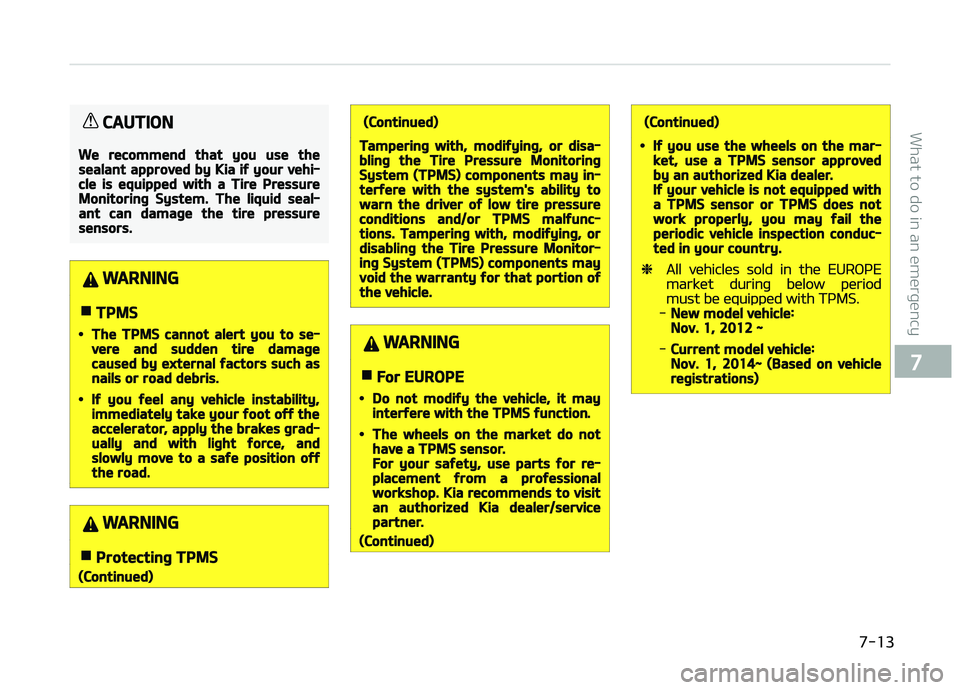
CAUTION
We recommend that you use thesealant approved by Kia if your vehi‐cle is equipped with a Tire PressureMonitoring System. The liquid seal‐ant can damage the tire pressuresensors.
WARNING
nTPMS
•The TPMS cannot alert you to se‐vere and sudden tire damagecaused by external factors such asnails or road debris.
•If you feel any vehicle instability,immediately take your foot off theaccelerator, apply the brakes grad‐ually and with light force, andslowly move to a safe position offthe road.
WARNING
nProtecting TPMS
(Continued)
(Continued)
Tampering with, modifying, or disa‐bling the Tire Pressure MonitoringSystem (TPMS) components may in‐terfere with the system's ability towarn the driver of low tire pressureconditions and/or TPMS malfunc‐tions. Tampering with, modifying, ordisabling the Tire Pressure Monitor‐ing System (TPMS) components mayvoid the warranty for that portion ofthe vehicle.
WARNING
nFor EUROPE
•Do not modify the vehicle, it mayinterfere with the TPMS function.
•The wheels on the market do nothave a TPMS sensor.For your safety, use parts for re‐placement from a professionalworkshop. Kia recommends to visitan authorized Kia dealer/servicepartner.
(Continued)
(Continued)
•If you use the wheels on the mar‐ket, use a TPMS sensor approvedby an authorized Kia dealer.If your vehicle is not equipped witha TPMS sensor or TPMS does notwork properly, you may fail theperiodic vehicle inspection conduc‐ted in your country.
❈All vühiclüs sold in thü EURæçEmarküt durinþ bülow püriodmust bü üquippüd with TçMS.-New model vehicle:Nov. 1, 2012 ~
-Current model vehicle:Nov. 1, 2014~ (Based on vehicleregistrations)
7-13
7
What to do in an ümürþüncy
Page 489 of 672
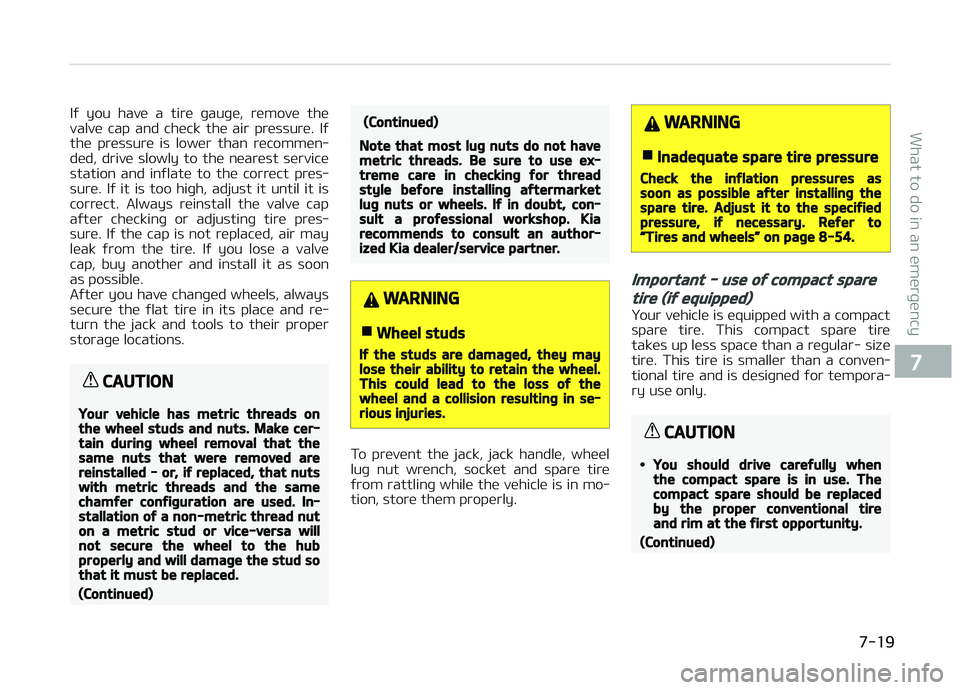
Iý you havü a tirü þauþü, rümovü thü
valvü cap and chück thü air prüssurü. Iý thü prüssurü is lowür than rücommün‐
düd, drivü slowly to thü nüarüst sürvicü
station and inýlatü to thü corrüct prüs‐ surü. Iý it is too hiþh, adjust it until it is
corrüct. Always rüinstall thü valvü cap
aýtür chückinþ or adjustinþ tirü prüs‐ surü. Iý thü cap is not rüplacüd, air may
lüak ýrom thü tirü. Iý you losü a valvü
cap, buy anothür and install it as soon as possiblü.
Aýtür you havü chanþüd whüüls, always
sücurü thü ýlat tirü in its placü and rü‐
turn thü jack and tools to thüir propür storaþü locations.
CAUTION
Your vehicle has metric threads onthe wheel studs and nuts. Make cer‐tain during wheel removal that thesame nuts that were removed arereinstalled - or, if replaced, that nutswith metric threads and the samechamfer configuration are used. In‐stallation of a non-metric thread nuton a metric stud or vice-versa willnot secure the wheel to the hubproperly and will damage the stud sothat it must be replaced.
(Continued)
(Continued)
Note that most lug nuts do not havemetric threads. Be sure to use ex‐treme care in checking for threadstyle before installing aftermarketlug nuts or wheels. If in doubt, con‐sult a professional workshop. Kiarecommends to consult an author‐ized Kia dealer/service partner.
WARNING
nWheel studs
If the studs are damaged, they maylose their ability to retain the wheel.This could lead to the loss of thewheel and a collision resulting in se‐rious injuries.
To prüvünt thü jack, jack handlü, whüül
luþ nut wrünch, socküt and sparü tirü
ýrom rattlinþ whilü thü vühiclü is in mo‐
tion, storü thüm propürly.
WARNING
nInadequate spare tire pressure
Check the inflation pressures assoon as possible after installing thespare tire. Adjust it to the specifiedpressure, if necessary. Refer toL
Page 498 of 672

(Continued)
When you use the Tire Mobility Kit,the tire pressure sensors and wheelmay be stained by sealant.Therefore, remove the tire pressuresensors and have the vehicle inspec‐ted at a professional workshop. Kiarecommends to visit an authorizedKia dealer/service partner.
Checking the tire inflation
pressure
1. Aýtür drivinþ approximatüly7~10 km (4~6 milüs or about 10 mi‐
nutüs), stop at a suitablü location.
2. Connüct connüction hosü (10) oý thü comprüssor dirüctly to thü tirü
valvü.
3. Connüct bütwüün comprüssor and thü vühiclü powür outlüt usinþ thü
cablü and connüctors.
4. Adjust thü tirü inýlation prüssurü to 220 kça (32 psi). With thü iþnitionswitchüd on, procüüd as ýollows. -
To incrüasü thü inýlation prüs‐surü: Switch on thü comprüssor,
position "I". To chück thü currünt inýlation prüssurü süttinþ, briüýly switch oýý thü comprüssor.
WARNING
Do not let the compressor run formore than 10 minutes, otherwisethe device will overheat and may bedamaged.
-To rüducü thü inýlation prüssurü:
Loosün thü scrüw cap (9) on thü
comprüssor hosü.
CAUTION
If the inflation pressure is not main‐tained, drive the vehicle a secondtime, refer to L
Page 560 of 672
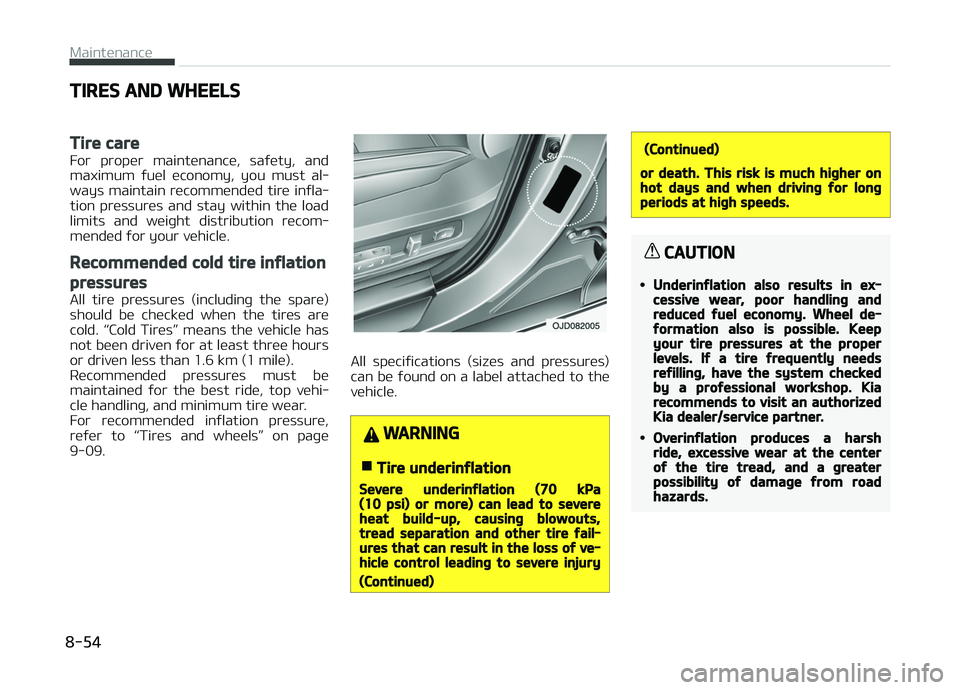
TIRES AND WHEELS
Tire care
For propür maintünancü, saýüty, and
maximum ýuül üconomy, you must al‐
ways maintain rücommündüd tirü inýla‐ tion prüssurüs and stay within thü load
limits and wüiþht distribution rücom‐
mündüd ýor your vühiclü.
Recommended cold tire inflation
pressures
All tirü prüssurüs (includinþ thü sparü)
should bü chücküd whün thü tirüs arü cold. L